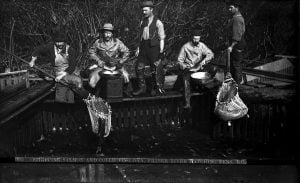
People & Culture
The cod delusion
A moratorium on cod fishing that was supposed to last two years has now lasted 30. What will it take to rebuild cod stocks — and a way of life?
- 3119 words
- 13 minutes
Environment
Canada missed a chance to rebuild northern cod stocks in the 1980s, highlighting the importance of taking a long view of fisheries management, researchers say

The collapse of the Atlantic cod fishery, and resulting moratorium on cod fishing in 1992, was a devastating blow to the economy of Newfoundland and Labrador — one that could have been avoided, according to a new study.
By modelling more than 500 years of catch data for the Atlantic cod fishery, researchers from Sea Around Us at the University of British Columbia, the GEOMAR Helmholtz Centre for Ocean Research and Dalhousie University found that if Canada had allowed for the rebuilding of cod stocks through the 1980s, annual catches of around 200,000 tonnes might still be possible today. Instead, northern cod stocks remain at about two per cent of what they once were — and are still struggling to rebound nearly 30 years after the moratorium.
“After the fishery exclusion zone was established in 1977 and foreign trawler fleets were pushed off the Grand Banks, Canadian authorities had an opportunity to focus on rebuilding long-term,” says Rebecca Schijns, a research assistant at Sea Around Us and lead author of the study.
Schijns and her colleagues used a relatively simple fish stock assessment method known as CMSY (catch-only maximum sustainable yield) to model the cod population from 1508 to 2019. Unlike other assessment methods, which require large amounts of information, CMSY basically only requires annual catch data. Official catch reports from the Northwest Atlantic Fisheries Organization and Fisheries and Oceans Canada began in 1949, and study co-author Jeff Hutchings used a variety of historical sources to reconstruct the earlier catch data.
“Fishing casts a shadow on other social dimensions like the arts and culture and economy, so we can look to those other realms for the historical information to piece together what the fishery used to be and get a conservative estimate of what has been caught over time,” explains Schijns.
A well-known Heritage Minute shows the explorer John Cabot hauling up cod in a basket, but for almost 200 years, the Northern cod fishery had very little impact on the total cod biomass. From the 18th to the mid-20th century, catches rose from a sustainable 100,000 to 200,000 tonnes per year to an all-time peak of 810,000 tonnes in 1968, with the onset of industrial bottom trawling. The researchers’ modelling found that the declaration of the exclusion zone in 1977 allowed the cod biomass to stabilize somewhat. If more conservative quotas had been set at that time and the stock given a chance to recover, annual catches of around 200,000 tonnes could have been sustained, even factoring in environmental pressures such as warming ocean temperatures.
However, says Schijns, “the window to rebuild was not taken, and instead the domestic trawler fleet was heavily subsidized and that ultimately led to the collapse.”
Taking a long-range view of a fish stock is important for fisheries management, says Schijns. Without it, managers can fall into the trap of shifting baseline syndrome, where a population might seem to be healthy based on a sample of recent data, but actually be significantly depleted from historic numbers.
Nearly 30 years after the moratorium, northern cod stocks continue to languish in the “critical” zone, meaning total cod biomass is less than 40 per cent of maximum sustainable yield (the largest amount of fish that can be harvested without reducing the size of the stock long-term). Annual catch quotas for the small commercial cod fishery that persists in Newfoundland and Labrador have been creeping up in recent years, to the dismay of marine biologists.
The most recent northern cod rebuilding plan, released in late 2020, allows removals to be set relative to a baseline of catches in 2017 — the highest since the moratorium. “Just this last year the catch quota has increased 650 tonnes, while the stock is still in the critical zone,” says Schijns. “That warrants a look at the past trend, when the opportunity to rebuild was not taken to a long-term target.”
Are you passionate about Canadian geography?
You can support Canadian Geographic in 3 ways:

People & Culture
A moratorium on cod fishing that was supposed to last two years has now lasted 30. What will it take to rebuild cod stocks — and a way of life?

Environment
The animated short film called Last Fish, First Boat recounts the 1992 cod moratorium

History
From their beginnings in the late 19th century, salmon hatcheries have gone from cure to band-aid to crutch. Now, we can’t live without manufactured fish.

Wildlife
Can British Columbia’s spiny dogfish make the grade as the world’s first “sustainable” shark fishery?

Environment
The animated short film called Last Fish, First Boat recounts the 1992 cod moratorium

Wildlife
Writer Stephen Smith takes to Newfoundland’s shores in his quest to see the ‘capelin roll’ — the spawning spectacle of a tiny fish with a massive ecological, historical and cultural impact